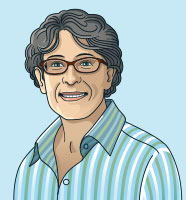
Irene Glowinski, CAS/BA '75, spent the early part of her career fighting diseases in the laboratory, but for the majority of it, she's fought to ensure that every dollar allocated to the Division of Microbiology and Infectious Diseases—part of the National Institutes of Health's National Institute of Allergy and Infectious Diseases—is spent judiciously. Her efforts have ensured that vaccines for some of the deadliest diseases are more readily available, thus saving lives around the world.
1953: Born in Jersey City, New Jersey. Her father was born and raised in Poland, her mother in Austria. They met in New York City at a bridge club. "I grew up in a Jewish family, and it was the ethic that nothing was more important than education."
1969: High school chemistry teacher Ms. Garbarino turned her on to chemistry. "My senior year I took more science classes—I loved them."
1971: First year at AU was a rude awakening. "I almost dropped out of college. I had very little self-confidence. I took that first general chemistry class—and I struggled. But I went and got help and eventually [thrived]."
1975: Chemistry department chair Leo Schubert called her into his office and convinced her to pursue pharmacology rather than enroll in pharmacy school. "I had never heard of it, but he was right: I wanted to study the effect of drugs on the body."
1980: Graduated with a PhD in pharmacology from the University of Michigan. Her thesis was on drug metabolism. She developed a mouse model for pharmacogenetics, the study of how genes affect a person's response to drugs.
1982: Landed a pharmacology research associate's training fellowship at NIH's National Cancer Institute.
1984: Realized that rather than spend her career in the lab, she wanted to work in the policy side of science. "Living in the DC area, you are constantly bombarded with what is going on around you, politically. That resonated with me."
1985: Worked for the US House Committee on Science and Technology as a Congressional Science Fellow. "Working on Capitol Hill allowed me to see how policies affecting the scientific enterprise are developed and acted on, sparking a life-long interest."
1989: Moved to the National Institute of General Medical Sciences, NIH's basic research unit. Visited graduate training programs in chemistry, biotechnology, and pharmacology around the country.
2000: Joined the Division of Microbiology and Infectious Diseases at NIH's National Institute of Allergy and Infectious Diseases (NIAID). At the time it employed about 60 people and had a $500 million budget to support infectious disease research. Ran the legislative policy and communications group.
2001: Following 9/11 and the anthrax attacks, everything changed. "This division has, as its mandate, research on all infectious diseases other than AIDS. We'd been funding research on anthrax and smallpox for years, but nothing big. All of a sudden those pathogens became very important, and Congress gave us a lot of money focused on biodefense."
2002: Over the next three years, her division's budget tripled to $1.5 billion, and staff increased to about 200.
2007: Became deputy director of the division. "My direct responsibilities are the budget, personnel, and the policy, legislation, and communications activities. I think of myself as the COO, running the day-to-day operations."
2014: NIAID was "intense" during the Ebola outbreak in West Africa. The institute's clinical division quickly developed a candidate vaccine and started clinical trials in Liberia. "We had been funding a contract to a company working on an Ebola vaccine way before the outbreak. Eventually there will be a licensed Ebola vaccine. That's a real win."
2017: Division is working on more than 300 pathogens. "Our priorities are malaria, tuberculosis, influenza, Zika, and Ebola. That doesn't mean we're not working on anything else—we're working on everything else."